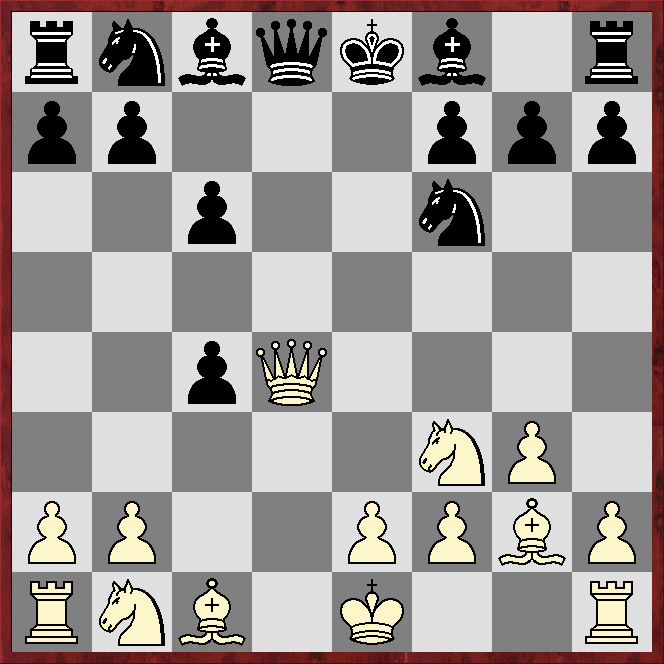Thanks to the strength of modern engines, most games are drawn, but occasionally one escapes that fate, or has some other particular point of interest.
Spanton (England 2320) - Kenneth Josefsson (Sweden 2005)
North Sea Team Tournament Board Six
English
1.c4 Nf6 2.g3 e5 3.Bg2 c6 4.d4 exd4 5.Qxd4 d5 6.Nf3 dxc4!?
The main line in ChessBase's 2025 Mega database runs 6...Be7 7.cxd5 cxd5 8.0-0 Nc6 9.Qa4, with a slight edge for White, according to Stockfish17 and Dragon1.
*****
*****
*****
*****
7.Qxc4
This is more popular than 7.Qxd8+, and scores 13 percentage points better, albeit Black's score against the text is an excellent 53%.
7...Be7 8.0-0 0-0
7...Be7 8.0-0 0-0
*****
*****
*****
*****
White has a small lead in development, and has the only pawn on the two centre files; Black has the endgame advantage of a farside pawn-majority. The engines give White a slight edge.
9.e4 Qa5!? 10.h3!?
A somewhat strange-looking novelty. Anthony Kosten (2510) - Christian Bauer (2420), Reims (France) Rapid 1994), went 10.Nc3 Be6 11.Qe2 Qh5!?, with an equal game, according to Stockfish17, although Dragon1 prefers White (1-0, 51 moves).
10...Na6 11.Nc3 Be6 12.Qe2 Qb4
Now 12...Qh5!?, borrowing a leaf from Kosten-Bauer, may not be so advisable, eg 13.g4 Qc5 14.Be3 Qc4 15.Nd4 Qxe2 16.Ncxe2 Bc4 17.Rac1 Bxe2 18.Nxe2 with the bishop-pair and active play for White.
13.a3 Qc4 14.Qc2 Rfd8 15.Be3 Bc5 16.Rfe1 Bxe3 17.Rxe3 Nc7 18.Rae1 h6!? 19.Nh4 Qc5 20.f4 g5!? 21.b4 Qe7 22.Nf3 a5 23.f5!?
*****
*****
*****
*****
23...Bd7
KJ said afterwards 23...axb4!? may be better, although 24.fxe6 bxc3 25.exf7+ Kxf7 26.Qxc3 leaves the black king rather exposed.
24.Qb2 axb4 25.axb4 b5 26.Nh2 Qe5!? 27.Nf3!?
*****
*****
*****
*****
27...Qe7
After 27...Qxg3?!, which for a long time is Dragon1's top choice, 28.Nd1!? looks very strong - the black king's knight is hanging, and the queen is short of good squares.
28.R3e2 Be8!? 29.e5 Ndf5 30.Nxd5 Nxd5 31.f6!? Qxb4
This time Black is more-or-less forced to accept the pawn sacrifice.
32.Qc2 Nc7 33.Nxg5! Qd4+
If 33...hxg5? then 34.Qf5, eg 34...Ne6 35.Be4 Qc5+ 36.Kh2 Nf8 37.Qxg5+ Ng6 38.h4 etc.
34.Kh2 Qd3
Again, capturing the knight is met by Qf5.
35.Qc1 Qg6 36.Ne4 Rd3
*****
*****
*****
*****
37.Nc5!?
The engines prefer 37.Nf2, but the text is also good.
37...Rda3
Or 37...Qxg3+ 38.Kh1, when Black has no good answer to 39.Qxh6.
38.Qf4 Nd5 39.Qf2 b4 40.Be4 Qh5 41.Bd3 R8a5 42.h4 Rxd3!?
Sacrificing the exchange to relieve pressure on Black's kingside. The engines prefer 42...Qg4, but after 43.Re4 Qg6 44.Rd4! they reckon Black will be forced to give up the exchange anyway, eg 44...Qh5 45.Re2! Rxc5 costs Black the queen after 46.g4.
43.Nxd3 Bd7 44.g4!? Qg6
Or 44...Bxg4 45.Qg3 Qg6 46.e6! Bxe6 47.Qxg6+ fxg6 48.Rxe6.
45.Nf4 Nxf4 46.Qxf4 Be6 47.Qxb4 Ra8 48.Qe4 Qxe4 49.Rxe4
*****
*****
*****
*****
49...Kh7 50.h5 c5 51.Rc1 Ra5 52.Kg3 c4 53.Kf4 Rc5 54.Rc3 1-0
Not for the first time with a correspondence game, I have been unable to pinpoint the moment the game left the drawing margin - nor, for that matter, can I mark any of the loser's moves as definite errors.






No comments:
Post a Comment